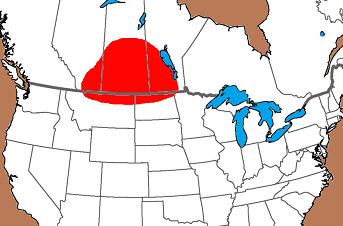Outline is Representative of Size and Shape:


Name Details:
Identified By: Ian Dyck and Richard E. Morlan
Named For: Bratton Phase
Date Identified: 1995
Type Site: Sjovold site, Albert, Canada
Identified By: Ian Dyck and Richard E. Morlan
Named For: Bratton Phase
Date Identified: 1995
Type Site: Sjovold site, Albert, Canada
Point Validity:
Valid type
Dyck was a distinguished archaeologist who worked as the curator for the Saskatchewan Museum of Natural History. Morlan was an influential archaeologist who developed the CARD system. This type was defined in a professional publication and has many professional references. This is considered a valid type.
Dyck was a distinguished archaeologist who worked as the curator for the Saskatchewan Museum of Natural History. Morlan was an influential archaeologist who developed the CARD system. This type was defined in a professional publication and has many professional references. This is considered a valid type.
Bratton Notched
Pelican Lake variationCluster:
Description of Physical Characteristics and Flaking Pattern:
This is a broad small to medium triangular corner to side notched point with a flattened to elliptical cross section. The blade may range from excurvate to rarely straight with the widest portion of the blade being just above the notches. Shallow parallel U or V notches may enter from the side or corner of the preform creating a wide neck and shoulders that are most commonly horizontal, but may vary to barbed. The stem is short and expanding and has rounded basal corners or ears. The base is convex (convex greater than 1 mm but less than 7 mm), with basal thinning and basal grinding present. This point is manufactured using random percussion flaking with pressure flaking used to trim and retouch the blade forming a random flaking pattern.
Size Measurements:
Commonly Utilized Material:
Additional Comments:
This type has been suggested that it is a Pelican Lake type point that is transitioning into a Besant type point (Kevinsen, 2013)
This type has been suggested that it is a Pelican Lake type point that is transitioning into a Besant type point (Kevinsen, 2013)
Distribution:

Distribution Comments:
These points are thought to be Pelican Lake type points that transitioned into Besant type points primarily found in Alberta and Saskatchewan and into Montana and North Dakota.
These points are thought to be Pelican Lake type points that transitioned into Besant type points primarily found in Alberta and Saskatchewan and into Montana and North Dakota.
Age / Periods:
Date: 3,000 - 1,300 B.P.
Cultural Period: Woodland
Glacial Period: Neoglacial to Roman Warm
Culture: Pelican Lake Culture / Bratton Phase
Date: 3,000 - 1,300 B.P.
Cultural Period: Woodland
Glacial Period: Neoglacial to Roman Warm
Culture: Pelican Lake Culture / Bratton Phase
Age Details:


